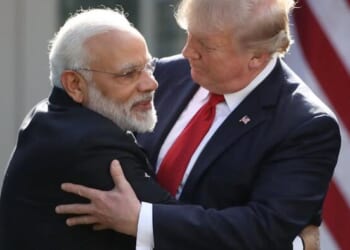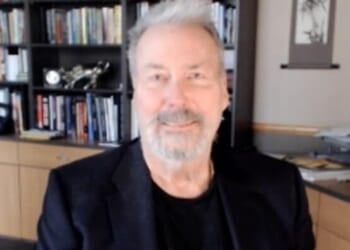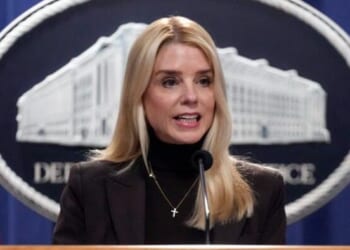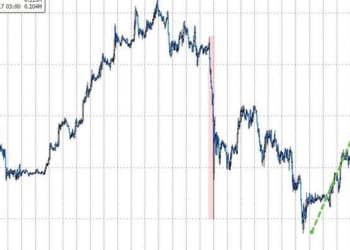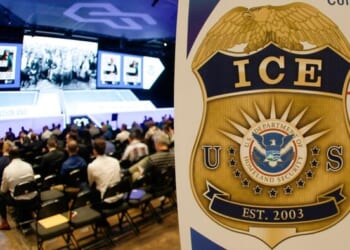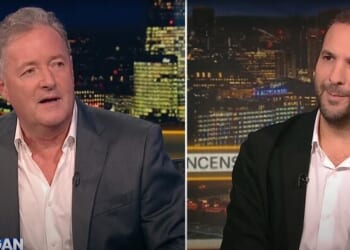You’re reading Dispatch Faith, our weekly newsletter exploring the biggest stories in religion and faith. Looking for more ways to support our work? Become a Dispatch member today.
In case you’ve missed it, the political right is engaged in something of a civil war. In oversimplified terms, the two camps are the old guard of the conservative project that came of age in America’s postwar years—the traditional conservatives, neoconservatives, religious conservatives, fusionists, Reaganites, etc. The other camp is more populist and became ascendant alongside Donald Trump. Its various factions are more distinct: postliberals, MAGA, Catholic integralists, nationalist conservatives, and so on. (Jonah Goldberg’s midweek G-file is a helpful primer on some of these divides.)
Christians like Dispatch Contributing Writer Jake Meador see the need for some of these groups to find common cause if they are to push out the vile factions (such as the Nick Fuentes-led groypers). To make this argument, Jake draws on the unlikely pair that reshaped the latter part of the 20th century for the better: Ronald Reagan and Pope John Paul II.
Jake Meador: The Fractured Right Should Learn From a Pope and a President

In a recent Dispatch Faith feature, Dan Hugger recalled the story of how National Review responded to Pope John XXIII’s 1961 encyclical Mater et Magistra—“Mother and Teacher,” rendered in English. Borrowing a phrase first coined by Garry Wills, William F. Buckley’s sister Priscilla wrote a reply titled, “Mater si, magistra no,” as a way of essentially saying that the Roman pontiff’s authority did not extend to certain political questions. It was the way many on the American right chose to respond to the pope’s teachings on economics, which were well to the left of Buckley’s movement, while still acknowledging papal authority in some sense.
The episode has an almost uncanny resemblance to one that played out with Democrats only a few years prior when then-presidential candidate John F. Kennedy gave his famed address on religious liberty in Houston:
I am not the Catholic candidate for President. I am the Democratic Party’s candidate for President who happens also to be a Catholic. I do not speak for my church on public matters; and the church does not speak for me. Whatever issue may come before me as President, if I should be elected, on birth control, divorce, censorship, gambling or any other subject, I will make my decision in accordance with these views — in accordance with what my conscience tells me to be in the national interest, and without regard to outside religious pressure or dictates. And no power or threat of punishment could cause me to decide otherwise.
Kennedy’s is but a longer expression of the same point Buckley intended. For both Kennedy and Buckley, the church could be mother, but “teacher” was a more complex matter. For both, then, their Catholicism was heavily conditioned and reframed by what was politically exigent in their moment.
Stories We Think You’ll Like
In time, this debate among conservatives would raise issues that would rupture Buckley’s own family: His brother-in-law, L. Brent Bozell Jr., would depart sharply from Buckley’s politics and end up becoming a proto-integralist of sorts, moving his family to Francoist Spain in search of a Christian social order, and founding a far-right Catholic magazine called Triumph.
Though it is mostly forgotten today, the response of many American political figures to Mater et Magistra reminds us of an important point: It is far from inevitable that an American political movement, even one led by devout Christians, will submit to the judgments of Christian churches on matters of politics. When push came to shove, Buckley and many others in the 1960s-era conservative movement were willing to dismiss the pope as a kind of quasi-leftist when it came to economic matters, just as Kennedy was willing to dismiss other elements of papal authority in his quest for the White House.
Thus the ordinary way this story has been remembered, when it is remembered at all, is as a kind of antecedent to today’s debates on the American right—with the older right-wing fusionists playing the role of Buckley and Bozell representing at least the Catholic portion of the new right. And, to be sure, there is something striking and alarming about how Bozell’s own embrace of Franco presaged the new right’s own flirtations with right-wing autocrats. (Daniel Kelly’s biography of Bozell is very much worth reading to get a fuller depiction of that era.) But there is another way one can read the story.
If the division between Buckleyites and John XXIII demonstrates the willingness of American political leadership to repudiate church teaching in political affairs, then it also suggests that the later alliance that developed between Pope St. John Paul II and President Ronald Reagan was not in any way obvious or predictable, even if many of us now looking back regard it as such. Indeed, if anything, the differences between John Paul II and Reagan were sharper than those between John XXIII and Buckley.
Reagan was a divorced and remarried nominal Presbyterian on the economic right who as governor liberalized California’s divorce laws and abortion restrictions. John Paul II, meanwhile, made a name for himself as a champion for the cause of life, and for writing a theology of the body that, among other things, supported the church’s robust opposition to divorce. He also authored Laborem Exercens, an encyclical that said that just societies were obliged to provide a “family wage” and to provide extensive support for the unemployed as a matter of basic justice. If the differences between a devout married Catholic of the American right and John XXIII could prompt “Mater si, magistra no” as a reply, then one would expect Reagan to have a similarly strong opposition to John Paul II. But he did not.
The reasons are twofold. First, in the years after his governorship, Reagan seemed to genuinely shift his position on social issues in directions closer to the positions of the Roman Catholic Church. This made it easier for a rapprochement between the Roman pontiff and the American president. But something else drew the two men together and made them realize the common cause they could share: Both men survived assassination attempts. Indeed, the two attempts happened within about six weeks of each other in the spring of 1981. While Reagan’s would-be assassin was severely mentally ill, a number of reputable figures, including an Italian parliamentary commission, believe that John Paul’s would-be assassin was backed by the Soviet Union. Significantly, neither Reagan nor John Paul responded to the attempts on their lives with bitterness or a desire to use the events to hurt their enemies in a petty, vindictive way. In fact, when John Paul was shot, the first thing he did was begin praying to Mary, to whom he had a particular devotion. In the aftermath of these attempts, Reagan wondered if his life had been spared so that he could help draw the Cold War to a peaceful, nonviolent end. Then after the attempt on John Paul II, Reagan issued a statement:
Pope John Paul II was wounded today while doing what he had done so well and so often throughout his travels—reaching out to others, offering hope, light, and the peace of God.
We are grateful that he has been spared. We pray that all of us will heed Pope John Paul’s call for a “world of love, not of hate;” that we will hear his words reminding us that all men are brothers, that they must forever forsake the ways of violence and live together in peace.
Later, Reagan and John Paul would meet privately for nearly an hour in Rome. According to author Paul Kengor, the men discussed their shared experience during that meeting and what they thought they were meant to do next:
In June 1982, the two men talked alone for 50 minutes in the Vatican Library. The attempted assassinations against them were raised right away. Both referred to the “miraculous” fact they had survived. They believed their lives had been spared for a special purpose, which they translated into a joint effort to take down atheistic Soviet communism. And their dagger to make that happen would be Poland—the wedge that both men believed could pierce and ultimately split the Soviet empire.
Bill Clark was there. He described that day to me as a “wonderful day” and a transformative one. He said that that day “gave the president and pope the ability to form a very personal relationship from then on.” The meeting led to real action. Reagan and John Paul II translated their lofty divine mission into a practical policy mission to sustain the Solidarity movement in Poland as the potential wedge that could split the USSR’s empire.
Solidarity was originally the name of a labor union that had by the 1980s evolved into a social movement in Poland led by onetime electrician Lech Walesa. And so the American president who in his domestic policy tended to be deeply hostile to organized labor was, in this case, a great friend to a nonviolent labor union that was also anti-authoritarian and pro-democracy.
What this suggests, then, is twofold: First, the relationship between the pope and the president presupposed that one could change one’s mind about important issues, as Reagan seems to have done on abortion. Second, one could navigate certain political differences in the name of accomplishing some greater good—in this case that good being a preservation of the rule of law and an opposition to totalitarian violence.
In other words, political coalitions are in some sense built around what their members regard as a common foe. Crucially, however, if the coalition is to be healthy, those oppositions must ultimately be rooted in higher loves that the coalition wishes to cultivate and pursue together. For John Paul and Reagan, that common love was the dignity of the human person, which they regarded as being threatened by “atheistic communism.”
But the fact remains that politics is both about organizing hatreds and cultivating commonly shared loves. The rule of law provides a transcendent moral force that binds us all, that defines those loves and hatreds, and saves us from arbitrary violence.
I have thought much about that unlikely friendship in recent weeks. What we are seeing now on the political right in America is a bizarre but not unsurprising spasm. On the one hand, there is a portion of the right—more libertarian in its economic sensibilities and hawkish in its foreign policy—that regards its positions as the best way to resist totalitarianism and antisemitism. Many holding to this package of beliefs are old enough to remember the Soviet Union and to have known people who served in World War II, so it is no surprise that they would be particularly alert to those evils. Elsewhere I have referred to this school as “right-wing conservatives.”
On the other hand, there is a rising generation of right-wingers, often called the new right or perhaps the dissident right, who are not particularly concerned with either of those things. Rather, they feel a deep sense of hopelessness about their lives—they doubt they will ever be able to own a home, escape economic precarity, or start a family. They look back at what they see and hear about the 1990s and 2000s and think (somewhat wrongly in my view, as someone born in 1987) that it was a particularly blessed time of both economic prosperity and social cohesion and they desire those same goods for themselves.
Since their adolescent years, many have felt attacked over things largely outside their control—to take one example, often relatively banal expressions of maleness were attacked as “toxic masculinity.” Meanwhile, following the social script handed to them by their elders—whatever you do, go to college!—has mostly just saddled them with enormous amounts of debt as they enter adulthood and find a precarious and uncertain job market. These factors generate a great deal of anger, anger which is often quite understandable. In some cases, this can take a still darker turn, leading to a search for someone to blame.
As a result of all this, they understand their political project as an attempt to use the power of the state to fix the problems that animate them and, often, to punish the people they blame for those problems. This is a largely doomed project for many complicated reasons, both moral and logistical. But understanding the motivations and inputs that produce such a political project is essential for knowing how to respond to it. I have referred to this bloc as “right-wing progressives,” which is a term I first read in the work of national conservatism author Nathan Levine, who has since gone to work for the Trump administration.
Two problems quickly develop given these conditions. First, the sheer scale of the anger and resentment among younger right-wingers generates lots of media attention from a variety of figures. The spectrum ranges from Jordan Peterson, who encourages them to take responsibility for their own lives, all the way to the antisemitism of Darryl Cooper, Candace Owens, and Tucker Carlson—all of whom are supplying them with a villain to blame for their troubles. This is also the same basic media ecosystem that includes figures like the Tocquevillian Catholic Patrick Deneen, the white nationalist Stephen Wolfe, and right-wing tech leaders like Peter Thiel and Elon Musk. All of these distinct figures and the movements they are trying to lead, some far more alarming than others, are trying to either direct these alienated individuals or capitalize on their rage.
The second problem is a predictable consequence of the first. Older conservatives frequently struggle to understand the resentment of the young and to differentiate among the various critics that younger media consumers are listening to. This was obviously the case in the much-discussed letter published on X by former leaders of the Intercollege Studies Institute. To older right-wing conservatives, sometimes derisively called “boomercons” by younger right-wingers, anything that doesn’t fit comfortably into the established camps of neo-conservatism, libertarianism, or the old religious right is seemingly unacceptable and suspect.
Yet surely there are vast differences between a Tocquevillian Catholic (who also has some pretty significant critiques of technological innovation) like Patrick Deneen and a techno-monarchist figure like Curtis Yarvin?
And that brings us to the situation currently playing out on the American right. The group we might think of as “right-wing conservatives” is generally older and slow to recognize the problems and fears and anger that define younger right-wingers, let alone the role their own policies may have played in generating that anger. The younger “right-wing progressives” have lost virtually all interest in “conserving” anything. Instead they simply are seeking to use state power to make their lives better and, in many cases, to punish the people they blame for their problems.
The outcome of these conditions could be disastrous for everyone.
Right-wing conservatives are fighting a losing battle as long as they insist that anything other than libertarianism, neo-conservatism, and the religious right are forbidden. As long as they stake out this position, they will find that their attempts to “conserve” mostly fail because the next generation thinks—not altogether wrongly—that it is the very things older generations wish to conserve that have created the problems now afflicting younger generations.
The fate of right-wing progressives may be darker. Once your vision of political life is reduced to rewarding friends and punishing enemies, as it seems to have become for figures like Matt Walsh and quite possibly Vice President J.D. Vance, you have lost the rule of law, whether you realize it or not. While you have power, this can work out for you, at least in material terms. (On the level of personal moral formation it is another matter, of course.)
But once you have committed to that position, you quite obviously have to maintain power at any cost, lest your political enemies use the same powers you have created to target you. This is why many right-wing progressives are also hostile to liberalism and democracy. Once you begin governing largely outside the norms and procedures of a democratic system, you legitimize such methods for everyone. And if you don’t want to be on the receiving end of such uses of power, then maintaining political control is a matter of existential survival. That is why we had riots at the Capitol on January 6, 2021, and why there has been no small amount of noise about President Donald Trump running for a third term, even if that has thankfully died down in recent weeks.
What is needed in our moment is our version of the common foe that was able to unite John Paul and Reagan. But that will only be found if we can first agree on a common love we seek to preserve against that enemy.
What might that love be? It ought to be the same thing that Reagan and John Paul found 40 years ago: a reverence for the dignity of the human person, and a deep conviction in the idea that every person should be able to live free from the fear of domination and arbitrary violence. That idea of human dignity is not the sole possession of Christianity, of course, or even of religious monotheists. Our current forms of talking about dignity often have as much to do with Immanuel Kant as they do Scripture. Yet it is likely the case that you do need certain Christian ideas in the background to create the context in which an idea like inviolable individual dignity is coherent and respected. That, at least, is the case you will find figures like Tom Holland, Glen Scrivener, and Nadya Williams making.
If that is true, then it may be the case that religious thinkers are uniquely equipped to resolve the tensions currently bubbling over on the American right and that the wisdom of the church may, in some sense, make her fit as both mother and teacher.
Nadya Williams: Why Should Christians Read Greco-Roman Classics?

Author, editor, and scholar Nadya Williams (one of the most prolific writers I know these days) discovered her love of the classic works of antiquity at a young age. She found her Christian faith a bit later (and after her family moved from the Soviet Union to Israel to the United States), but it was in part her love of and appreciation for classic works of literature, such as Virgil’s Aeneid, that helped her to love what she read in the Gospels. She’s just released a new book about it all, and today has an essay on our site that unpacks her backstory.
Reading Greek was instrumental for my conversion, in hindsight—because reading the Gospels in the original Greek felt powerful in that indescribable, goosebumps-inducing way. Here was I, about as close, linguistically at least, to the texts early Christians once heard read aloud in worship. Those who could also read them for themselves in private, and some even wore these texts as amulets around the neck or carried them around as miniature codices. Reading the Gospels as a seeker and new believer took me back to the visceral memory of reading Virgil’s Aeneid—the first unadapted Latin poetry I ever read!—at age 17. At the time of that first encounter, it took hours to read a couple of verses, taking them apart, looking up what felt like every word in the dictionary, figuring out the grammatical structure and the meter, and finally understanding what the words said—literally, at least. There was a moment of sheer awe at the end, as I felt this miraculous connection to an author who lived and died more than two millennia earlier, yet whose own words I was reading now.
It was a version of this same emotion that I felt all the more powerfully 13 years later, when I was reading the Gospels in search of Christ. To add even more pathos, it was the night bridging Saturday to Sunday at the Amsterdam airport, where I was stuck on a layover overnight—knowingly and willingly. I was on my way home from an academic conference in Glasgow, and didn’t want to bother finding a hotel room for those few hours before morning. Spending a night reading the Gospels, one after another, in a silent airport, led to a conviction that the words were true, and this truth had demands upon my life. The next Sunday, I was in church for the first time.
More Sunday Reads
- On his Substack American Storylines, pollster Daniel Cox splashes a bit of cold water on the popular notion that Americans may be returning to religion generally. While online expressions of faith may indicate one thing, the deeper practices of those committed to faith say another, Cox writes. “Headlines heralding a return of religion to the public square and social media accounts promoting religious and spiritual content are greeted with more interest and affirmation. A Pew study found that, for the first time in more than two decades, a growing share of the public believes that religion is gaining influence in American life. Even more importantly, the public’s evaluation of religion’s role in society has grown more positive. The same study found that a growing number of Americans express a positive opinion about the role of religion in public life—either celebrating its rise or registering dismay about its decline. I’m not sure whether Gen Z’s renewed religious interest will translate into lasting commitments, but there’s reason to be doubtful. As podcasts and apps become the focal points of Gen Z’s religious interest, attendance rates at in-person services continue to fall. Online displays of religiosity can appear more as an aesthetic accessory or lifestyle brand rather than a guiding set of values or social community. The type of performative religiosity and spirituality found on social media, even if it is personally meaningful, bypasses traditional requirements of religious practice. Religious identities and spiritual practices are easily adopted and just as easily discarded. With young adults mostly disinterested in joining traditional religious organizations and inherently mistrustful of their leadership, it’s possible that even as we see the emergence of invigorated public religiosity online, many of America’s places of worship will continue to decay and disappear.”
- For Law and Liberty, scholar Jacob Williams proposes a novel concept for reconciling tensions some perceive among Muslims and the West: an adapted sort of fusionism—which couples libertarianism and traditionalism—envisioned by philosopher Frank Meyer. “But in the meantime, at the level of practical politics, Muslims need fusionism. Many Muslims in the West are clearly seeking a theological rationale for a principled reconciliation with the commitment to pluralism and religious liberty of the societies in which they live (and which are in many cases now the only ones they have ever known). Secular and progressive versions of liberalism manifestly, and understandably, lack appeal. Fusionism, however, allows religiously conservative Muslims to have it both ways: the state has a legitimate interest in religion and should not be neutral about the nature of human flourishing, but it can express this interest in ways compatible with the kind of religious and personal freedoms to which the modern West is committed. Western Muslims need fusionism—and the West, too, needs Muslim fusionism. Almost all the anxieties about Islam’s ‘compatibility’ with Western societies ultimately boil down to the theologico-political problem of liberty. If Muslims can commit themselves in principle to the equal liberty of all citizens with respect to religious practice, conversion, and proselytisation, and to respecting personal freedom even when used for vicious ends, no one with sense will object to their holding traditional beliefs about family and sexuality that are shared with members of the other Abrahamic faiths. My fear is that without this principled reconciliation, Muslim life in the West will remain a pragmatic modus vivendi—and Muslims will continue to be suspected, sometimes justly, of being ‘resident aliens’ whose real loyalty is to something or somewhere else.”
Religion in an Image




